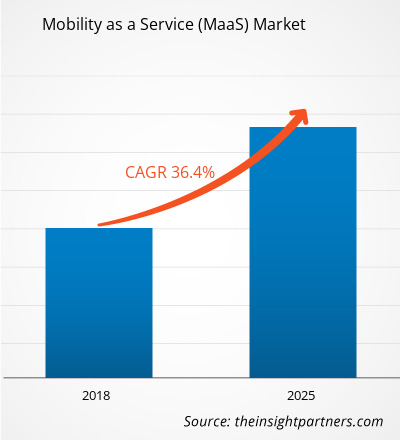モビリティ・アズ・ア・サービス(MaaS)市場は、2025年に約3,987億9,000万米ドルと評価されました。2034年までに4,7211億5,000万米ドルに達すると予測されており、2026年から2034年までの年間複合成長率(CAGR)は約31.6%となります。
モビリティ・アズ・ア・サービス市場分析
MaaS市場の予測は、都市化の進展、スマートシティ構想、そして統合交通ソリューションへの推進に牽引され、力強い成長を示しています。The Insight Partnersのレポートによると、複数のモビリティサービス(配車サービス、カーシェアリング、バスシェアリング、自転車シェアリング)を統合プラットフォームに統合することが、市場拡大の推進において重要な要素となっています。
この成長は、モバイル接続、GPS、データ分析といったデジタル技術の進歩によってさらに支えられており、MaaSプラットフォーム内で様々な交通手段をシームレスに統合することが可能になっています。さらに、交通エコシステムにおける官民パートナーシップと、それを支援する政府規制が、地域全体でMaaSソリューションの導入を促進しています。
モビリティ・アズ・ア・サービス市場の概要
モビリティ・アズ・ア・サービス(MaaS)とは、ユーザー中心の交通コンセプトであり、顧客が単一のデジタルプラットフォームを通じて様々なモビリティサービスの計画、予約、支払いを行えるようにします。このモデルは、タクシー、レンタカー/リース、自転車シェアリング、公共交通機関、バスシェアリングなど、複数の交通手段を1つのサービスに統合します。
MaaSシステムは、モビリティへのアクセスを簡素化することで、自家用車への依存を減らし、交通網を最適化し、ユーザーエクスペリエンス全体を向上させることを目指しています。旅程計画、統合された発券・決済、そしてサービスプロバイダー間のリアルタイム連携を可能にします。
要件に合わせてレポートをカスタマイズ
このレポートの一部、国レベルの分析、Excelデータパックなど、あらゆるレポートを無料でカスタマイズできます。また、スタートアップや大学向けのお得なオファーや割引もご利用いただけます。
モビリティ・アズ・ア・サービス(MaaS)市場:戦略的洞察

-
このレポートの主要な市場動向を入手してください。この無料サンプルには、市場動向から見積もりや予測に至るまでのデータ分析が含まれます。
モビリティ・アズ・ア・サービス市場の推進要因と機会
市場の推進要因:
- 急速な都市化とスマートシティの開発: 都市はモビリティをより効率的に管理するためにインテリジェントな交通システムとデジタル プラットフォームに投資しており、これが MaaS の需要を促進しています。
- 多様なモビリティ サービスの統合: 断片化された交通手段から統合プラットフォーム (ライド ヘイリング、カー シェアリング、バス シェアリング) への移行が成長を促進しています。
- 技術の進歩とデジタル接続: モバイル アプリ、データ分析、GPS 追跡、接続インフラストラクチャは、MaaS プラットフォームの配信と最適化をサポートします。
市場機会:
- 新興市場の拡大: 都市人口とモビリティ需要が増加している発展途上地域では、MaaS ソリューションの成長の可能性が秘められています。
- サブスクリプション/プラットフォーム ビジネス モデル: MaaS が進化するにつれて、従量課金制、サブスクリプション モビリティ バンドル、統合サービス エコシステムなどのビジネス モデルを採用および拡張する機会が生まれます。
- 持続可能性とモビリティの電動化: 車両の所有を減らし、排出量を削減するという取り組みにより、MaaS 事業者が電気自動車やシェアード車両、持続可能な輸送モード、マルチモーダル サービスを統合する道が開かれます。
モビリティ・アズ・ア・サービス市場レポート:セグメンテーション分析
サービスタイプ別:
- 自動運転サービス
- 配車サービス
- カーシェアリング
- 自転車シェアリング
- バスシェアリング
アプリケーションプラットフォーム別:
- アンドロイド
- iOS
ビジネスモデル別:
- B2B(企業間取引)
- B2C(企業対消費者)
- P2P(ピアツーピア)
車種別:
- 乗用車
- 自転車
- バス
地理別:
- 北米
- ヨーロッパ
- アジア太平洋
- 南米と中央アメリカ
- 中東・アフリカ
モビリティ・アズ・ア・サービス(MaaS)市場の地域別インサイト
The Insight Partnersのアナリストは、予測期間全体を通してモビリティ・アズ・ア・サービス(MaaS)市場に影響を与える地域的なトレンドと要因を徹底的に解説しています。本セクションでは、北米、ヨーロッパ、アジア太平洋、中東・アフリカ、中南米におけるモビリティ・アズ・ア・サービス(MaaS)市場のセグメントと地域についても解説します。
モビリティ・アズ・ア・サービス(MaaS)市場レポートのスコープ
| レポート属性 | 詳細 |
|---|---|
| 2025年の市場規模 | 3,987億9,000万米ドル |
| 2034年までの市場規模 | 4,7211億5000万米ドル |
| 世界のCAGR(2026年~2034年) | 31.6% |
| 履歴データ | 2021-2024 |
| 予測期間 | 2026~2034年 |
| 対象セグメント |
サービスタイプ別
|
| 対象地域と国 |
北米
|
| 市場リーダーと主要企業の概要 |
|
モビリティ・アズ・ア・サービス(MaaS)市場のプレーヤー密度:ビジネスダイナミクスへの影響を理解する
モビリティ・アズ・ア・サービス(MaaS)市場は、消費者の嗜好の変化、技術の進歩、製品メリットへの認知度の向上といった要因によるエンドユーザー需要の高まりに牽引され、急速に成長しています。需要の高まりに伴い、企業は提供サービスの拡充、消費者ニーズへの対応のためのイノベーション、そして新たなトレンドの活用を進めており、これが市場の成長をさらに加速させています。

- モビリティ・アズ・ア・サービス(MaaS)市場のトップキープレーヤーの概要を入手
地域別モビリティ・アズ・ア・サービス市場シェア分析
北米
モビリティ サービスの早期デジタル導入、シェア モビリティ エコシステムの確立、スマート輸送インフラへの投資により、大きなシェアを占めています。
ヨーロッパ
シェアードモビリティ、マルチモーダル統合、持続可能性の義務化を支持する規制枠組みによって支えられた強力なシェア。
アジア太平洋
急速な都市化、可処分所得の増加、中国、インド、日本、オーストラリアなどの国々における統合モビリティ ソリューションに対する高い需要により、レポートの予測期間中に最も急速に成長する地域として特定されています。
南米・中米、中東・アフリカ
これらの地域では、都市が拡大し、モビリティの需要が高まるにつれて、MaaS プロバイダーにとって新たな機会が生まれますが、インフラストラクチャとサービスの統合は、より成熟した市場に遅れをとる可能性があります。
モビリティ・アズ・ア・サービス市場のプレーヤー密度:ビジネスダイナミクスへの影響を理解する
MaaS市場には、多くのテクノロジープロバイダー、モビリティオペレーター、スタートアップ企業、プラットフォームインテグレーターが参入しており、競争が激化しています。主要プレーヤーは、サービス統合、プラットフォームの拡張性、ユーザーエクスペリエンス、そして公共交通機関とシェアードモビリティを横断したパートナーシップを通じて、差別化を図ろうとしています。
ベンダーは次の点に重点を置いています。
- 複数のモビリティサービス(配車サービス、シェアリングサービス、公共交通機関)のシームレスな統合
- プラットフォームのスケーラビリティとマルチモーダルオーケストレーション
- データ分析、リアルタイム最適化、コネクテッドモビリティソリューション
- モビリティサービス事業者、技術プロバイダー、地方自治体間のパートナーシップ
モビリティ・アズ・ア・サービス(MaaS)市場で事業を展開している主要企業は次のとおりです。
- リフト株式会社
- ウーバーテクノロジーズ株式会社
- ビーライン・シンガポール
- SkedGo Pty Ltd.
- ユビゴAB
- MaaSグローバル社
- ムーベルグループGmbH
- キクシット
- スプリットテクノロジーズ株式会社
調査の過程で分析した他の企業:
- グラブ・ホールディングス・リミテッド
- ブラブラカー
- ムービット株式会社
- 今すぐ無料
- キュービック交通システムズ株式会社
- 滴滴出行テクノロジー株式会社
- オラキャブ
- キャビファイ
- ヴォイテクノロジーAB
- シェアードモビリティ株式会社
モビリティ・アズ・ア・サービス市場のニュースと最近の動向
- Insight Partners のレポートでは、MaaS プラットフォームが公共交通機関、配車サービス、自転車シェアリング、カーシェアリングを統合されたモビリティ エコシステムに統合し、シームレスなユーザー ジャーニーを実現して輸送効率を向上させていることが強調されています。
- アジア太平洋地域の急速な成長は注目すべき傾向であり、モビリティ サービスの採用とインフラストラクチャの開発の増加により、この地域は成熟市場と比較して高い CAGR で成長すると予測されています。
- モビリティ サービス プロバイダーと自治体間のパートナーシップやコラボレーションが増加し、統合モビリティ プラットフォーム、スマート交通ハブ、データ駆動型モビリティ管理ソリューションの導入が可能になっています。
モビリティ・アズ・ア・サービス市場レポートの対象範囲と成果物
「モビリティ・アズ・ア・サービス(MaaS)市場規模と予測(2021~2034年)」レポートでは、以下の詳細な分析を提供しています。
- 主要セグメントにおける世界、地域、国レベルでのMaaS市場規模と予測
- 市場の動向とダイナミクス:推進要因、制約、主要な機会
- 詳細なPEST(政治、経済、社会、技術)およびSWOT(強み、弱み、機会、脅威)分析
- 業界の状況と競争分析:市場集中、地理的ヒートマップ分析、主要プレーヤー、最近の動向
- MaaSエコシステムの主要プレーヤーの詳細な企業プロフィール
- 過去2年間の分析、基準年、CAGRによる予測(7年間)
- PEST分析とSWOT分析
- 市場規模価値/数量 - 世界、地域、国
- 業界と競争環境
- Excel データセット
最新レポート
お客様の声
購入理由
- 情報に基づいた意思決定
- 市場動向の理解
- 競合分析
- 顧客インサイト
- 市場予測
- リスク軽減
- 戦略計画
- 投資の正当性
- 新興市場の特定
- マーケティング戦略の強化
- 業務効率の向上
- 規制動向への対応






















 無料サンプルを入手 - モビリティ・アズ・ア・サービス(MaaS)市場
無料サンプルを入手 - モビリティ・アズ・ア・サービス(MaaS)市場